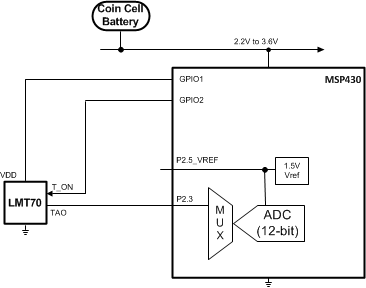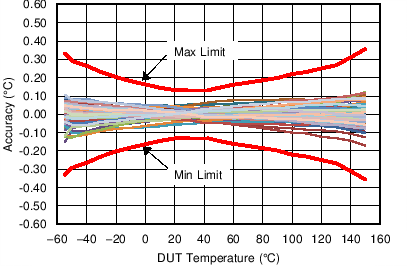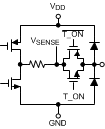-
LMT70、LMT70A ±0.05°C 精密模拟温度传感器、RTD 和精密 NTC 热敏电阻 IC
- 1 特性
- 2 应用
- 3 说明
- 4 宽温度范围、精密、有源 RTD 或 NTC 的替代产品(−55°C 至 150°C)
- 5 修订历史记录
- 6 Device Comparison Table
- 7 Pin Configuration and Functions
- 8 Specifications
- 9 Detailed Description
- 10Application and Implementation
- 11Power Supply Recommendations
- 12Layout
- 13器件和文档支持
- 14机械、封装和可订购信息
- 重要声明
DATA SHEET
LMT70、LMT70A ±0.05°C 精密模拟温度传感器、RTD 和精密 NTC 热敏电阻 IC
本资源的原文使用英文撰写。 为方便起见,TI 提供了译文;由于翻译过程中可能使用了自动化工具,TI 不保证译文的准确性。 为确认准确性,请务必访问 ti.com 参考最新的英文版本(控制文档)。
1 特性
2 应用
- 物联网 (IoT) 传感器节点
- 工业电阻式温度检测器 (RTD)(AA 类)或精密 NTC/正温度系数 (PTC) 热敏电阻的替代产品
- 医疗/健身设备
- 医疗温度计
- 人体温度监视器
- 计量温度补偿
3 说明
LMT70 是一款带有输出使能引脚的超小型、高精度、低功耗互补金属氧化物半导体 (CMOS) 模拟温度传感器。 LMT70 几乎适用于所有高精度、低功耗的经济高效型温度感测应用,例如物联网 (IoT) 传感器节点、医疗温度计、高精度仪器仪表和电池供电设备。 LMT70 也是 RTD 和高精度 NTC/PTC 热敏电阻的理想替代产品。
多个 LMT70 可利用输出使能引脚来共用一个模数转换器 (ADC) 通道,从而简化 ADC 校准过程并降低精密温度感测系统的总成本。 LMT70 还具有一个线性低阻抗输出,支持与现成的微控制器 (MCU)/ADC 无缝连接。 LMT70 的热耗散低于 36µW,这种超低自发热特性支持其在宽温度范围内保持高精度。
LMT70A 具有出色的温度匹配性能,同一卷带中取出的相邻两个 LMT70A 的温度最多相差 0.1°C。 因此,对于需要计算热量传递的能量计量应用而言,LMT70A 是一套理想的解决方案。
器件信息(1)
| 器件型号 | 封装 | 封装尺寸(标称值) |
|---|---|---|
| LMT70 | DSBGA - WLCSP (4) YFQ | 0.88mm x 0.88mm |
(1) 要了解所有可用封装,请见数据表末尾的可订购产品附录。
4 宽温度范围、精密、有源 RTD 或 NTC 的替代产品(−55°C 至 150°C)

4.0.0.1 LMT70 精度与温度间的关系

5 修订历史记录
Changes from * Revision (March 2015) to A Revision
- Added 典型精度规范。Go
- 已将 ±0.2°C 精度的温度范围从“20°C 至 90°C”扩展至“-20°C 至 90°C”。Go
- Added 9.2µA(典型值)Go
- Updated schematicGo
- Added -20°C accuracy specification Go
- Changed from 20°C to 20°C to 42°C for accuracy specification condition Go
- Added 50°C accuracy specification Go
- Added typical supply current specification.Go
- Changed from 942.547 to 942.552Go
- Changed from 943.907 to 943.902Go
- Changed from 890.423 to 890.500Go
- Changed from 891.934 to 891.857Go
- Added -20°C histogram curveGo
- Removed erroneous 10°C histogramGo
- Changed y axis units from (V) to (mV)Go
- Added Output Noise vs Frequency curveGo
6 Device Comparison Table
| Order Number | Matching Specification Provided(1) |
|---|---|
| LMT70YFQR, LMT70YFQT | No |
| LMT70AYFQR, LMT70AYFQT | Yes, 0.1°C at approximately 30°C(1) |
(1) In order to meet the matching specification of the LMT70A, two units must be picked from adjacent positions from one tape and reel. If PCB rework is required, involving the LMT70A, then the pair of the LMT70A matched units must be replaced. Matching features (which include, without limitation, electrical matching characteristics of adjacent Components as they are delivered in original packaging from TI) are warranted solely to the extent that the purchaser can demonstrate to TI’s satisfaction that the particular Component(s) at issue were adjacent in original packaging as delivered by TI. Customers should be advised that the small size of these Components means they are not individually traceable at the unit level and it may be difficult to establish the original position of the Components once they have been removed from that original packaging as delivered by TI.
7 Pin Configuration and Functions
DSBGA or WLCSP
4 Pins YFQ
(Top View)


